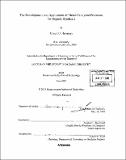The development and application of metal-catalyzed processes for organic synthesis
Author(s)
Hennessy, Edward J. (Edward John), 1977-
DownloadFull printable version (7.516Mb)
Other Contributors
Massachusetts Institute of Technology. Dept. of Chemistry.
Advisor
Stephen L. Buchwald.
Terms of use
Metadata
Show full item recordAbstract
Chapter 1. Copper-Catalyzed Arylation of Stabilized Carbanions A mild, general catalytic system for the synthesis of [alpha]-aryl malonates has been developed. Aryl iodides bearing a variety of functional groups can be effectively coupled to diethyl malonate in high yields using inexpensive and widely available reagents, making this a superior method to those previously described that employ copper reagents or catalysts. The functional group tolerance of the process developed makes it complementary to analogous palladium-catalyzed couplings. Importantly, a set of mild reaction conditions has been developed that minimize product decomposition, a problem that had not been addressed previously in the literature. In addition, the utilization of aryl bromides as coupling partners has been investigated, as well as the use of other classes of nucleophilic stabilized carbanions. Chapter 2. Synthesis of Oxindoles from a-Haloacetanilides via Palladium-Catalyzed C-H Functionalization We have discovered a palladium-catalyzed reaction that efficiently produces oxindoles from a-haloacetanilides through a net functionalization of an arene C-H bond. The high levels of regioselectivity observed in this cyclization obviate the need for highly functionalized aromatic substrates to effect desired ring closure. Moreover, the breadth of functional groups compatible with the reaction conditions is vastly greater than that of analogous Lewis acid-mediated processes. Extensive mechanistic work has been conducted, including kinetic isotope effect and linear free energy relationship studies. (cont.) A number of plausible pathways are consistent with our data and with previously published examples of palladium-catalyzed C-H functionalization processes. Chapter 3. Synthesis of DAPHAnalogs via Palladium-Catalyzed Amination DAPH (4,5-dianilinophthalimide) has previously been shown to reverse the formation of neurotoxic fibrils associated with Alzheimer's disease. We have developed a synthetic route to DAPH and structurally-related analogs that employs palladium- catalyzed amination as the key bond-forming step. The requisite substrates are easily obtained, and their coupling with substituted anilines proceeds in generally high yields. Thus, a variety of DAPH analogs can be quickly accessed in a modular fashion. In addition, the route described herein should also be amenable to the incorporation of other classes of nucleophiles into the molecular framework. The results of biological assays conducted thus far will serve as a guide for further lead optimization
Description
Thesis (Ph. D.)--Massachusetts Institute of Technology, Dept. of Chemistry, 2005. Vita. Includes bibliographical references.
Date issued
2005Department
Massachusetts Institute of Technology. Department of ChemistryPublisher
Massachusetts Institute of Technology
Keywords
Chemistry.